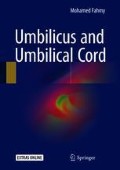Abstract
The umbilicus embryologically represents the neck of the bottle, which contains the umbilical vessels and structures related to the digestive and urinary systems. After the fall of the umbilical stump, a few days after birth, its scarred tissue remains as the belly button, which is considered a mirror of the abdomen and should be carefully checked, particularly for newborns. A basic understanding of its anatomy and embryology is essential to identify and manage its disorders. Investigating the abnormal conditions at the umbilicus is crucial, because corrective surgical interventions may be required and conducted as soon as possible.
The umbilicus also represents a relatively weak point in the anterior abdominal wall that is prone to herniation or bulging as a result of increased intra-abdominal pressure. Moreover, most abnormal conditions observed at the umbilicus are attributed to developmental disorders. Thus, focusing on the development of the umbilicus and its congenital anomalies and correlating these conditions with clinical findings are necessary, and also types and shapes of the umbilicus and its position had some clinical correlations.
References
Bert A, Charles Y. Etude sur la morphologic de l’ombilic. Compt. rend, de l’assoc. des anatomistes. 104, vi, 116.
Cullen TS. Anatomy of the umbilical region. In: Cullen TS, editor. Embryology, anatomy, and disease of the umbilicus together with diseases of the Urachus. Philadelphia: WB Saunders; 1916. p. 34–89.
Yu D, Novicoff WM, Gampper TJ. The average size and position of the umbilicus in young men and women. Ann Plast Surg. 2016;76(3):346–8.
Abbas H, Guneren E, Eroglu LO, Uysal A. A natural looking umbilicus as an important part of abdominoplasty. Aesthet Plast Surg. 2003;27:139.
Shinohara H, Matsuo K, Kikuchi N. Umbilical reconstruction with an inverted C-V flap. Plast Reconstr Surg. 2000;105:703–5.
Lee SL, DuBois JJ, Greenholz SK, et al. Advancement flap umbilicoplasty after abdominal wall closure: postoperative results compared with normal umbilical anatomy. J Pediatr Surg. 2001;36:1168–70.
Tsukahara M, Fernandez GI. Umbilical findings in Aarskog syndrome. Clin Genet. 1994;45:260–5.
Shephard BD, Shephard CA. The complete guide to Women’s health. Tampa: Mariner Publishing; 1982. p. 419. http://hdl.handle.net/10822/792311
Author information
Authors and Affiliations
Rights and permissions
Copyright information
© 2018 Springer International Publishing AG
About this chapter
Cite this chapter
Fahmy, M. (2018). Umbilicus Types and Shapes. In: Umbilicus and Umbilical Cord. Springer, Cham. https://doi.org/10.1007/978-3-319-62383-2_22
Download citation
DOI: https://doi.org/10.1007/978-3-319-62383-2_22
Published:
Publisher Name: Springer, Cham
Print ISBN: 978-3-319-62382-5
Online ISBN: 978-3-319-62383-2
eBook Packages: MedicineMedicine (R0)

